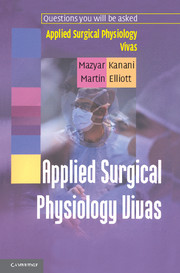Book contents
- Frontmatter
- Contents
- List of Abbreviations
- Dedication
- Preface
- A Change in Posture
- Acid-Base
- Action Potentials
- Adrenal Cortex I
- Adrenal Cortex II – Clinical Disorders
- Adrenal Medulla
- Arterial Pressure
- Autonomic Nervous System (ANS)
- Carbon Dioxide Transport
- Cardiac Cycle
- Cardiac Output (CO)
- Cell Signalling
- Cerebrospinal Fluid (CSF) and Cerebral Blood Flow
- Colon
- Control of Ventilation
- Coronary Circulation
- Fetal Circulation
- Glomerular Filtration and Renal Clearance
- Immobilization
- Liver
- Mechanics of Breathing I – Ventilation
- Mechanics of Breathing II – Respiratory Cycle
- Mechanics of Breathing III – Compliance and Elastance
- Mechanics of Breathing IV – Airway Resistance
- Microcirculation I
- Microcirculation II
- Micturition
- Motor Control
- Muscle I – Skeletal and Smooth Muscle
- Muscle II – Cardiac Muscle
- Nutrition: Basic Concepts
- Pancreas I – Endocrine Functions
- Pancreas II – Exocrine Functions
- Potassium Balance
- Proximal Tubule and Loop of Henle
- Pulmonary Blood Flow
- Renal Blood Flow (RBF)
- Respiratory Function Tests
- Small Intestine
- Sodium Balance
- Sodium and Water Balance
- Starvation
- Stomach I
- Stomach II – Applied Physiology
- Swallowing
- Synapses I – The Neuromuscular Junction (NMJ)
- Synapses II – Muscarinic Pharmacology
- Synapses III – Nicotinic Pharmacology
- Thyroid Gland
- Valsalva Manoeuvre
- Venous Pressure
- Ventilation/Perfusion Relationships
Synapses II – Muscarinic Pharmacology
Published online by Cambridge University Press: 06 January 2010
- Frontmatter
- Contents
- List of Abbreviations
- Dedication
- Preface
- A Change in Posture
- Acid-Base
- Action Potentials
- Adrenal Cortex I
- Adrenal Cortex II – Clinical Disorders
- Adrenal Medulla
- Arterial Pressure
- Autonomic Nervous System (ANS)
- Carbon Dioxide Transport
- Cardiac Cycle
- Cardiac Output (CO)
- Cell Signalling
- Cerebrospinal Fluid (CSF) and Cerebral Blood Flow
- Colon
- Control of Ventilation
- Coronary Circulation
- Fetal Circulation
- Glomerular Filtration and Renal Clearance
- Immobilization
- Liver
- Mechanics of Breathing I – Ventilation
- Mechanics of Breathing II – Respiratory Cycle
- Mechanics of Breathing III – Compliance and Elastance
- Mechanics of Breathing IV – Airway Resistance
- Microcirculation I
- Microcirculation II
- Micturition
- Motor Control
- Muscle I – Skeletal and Smooth Muscle
- Muscle II – Cardiac Muscle
- Nutrition: Basic Concepts
- Pancreas I – Endocrine Functions
- Pancreas II – Exocrine Functions
- Potassium Balance
- Proximal Tubule and Loop of Henle
- Pulmonary Blood Flow
- Renal Blood Flow (RBF)
- Respiratory Function Tests
- Small Intestine
- Sodium Balance
- Sodium and Water Balance
- Starvation
- Stomach I
- Stomach II – Applied Physiology
- Swallowing
- Synapses I – The Neuromuscular Junction (NMJ)
- Synapses II – Muscarinic Pharmacology
- Synapses III – Nicotinic Pharmacology
- Thyroid Gland
- Valsalva Manoeuvre
- Venous Pressure
- Ventilation/Perfusion Relationships
Summary
1. Name some drugs that activate muscarinic cholinoceptors. What are these compounds used for?
These may be of two broad types based on the mechanism of muscarinic activation:
Through direct stimulation: examples include carbachol, bethanechol and pilocarpine. Bethanechol has been used for the management of postoperative paralytic ileus and urinary retention. Pilocarpine is used for the management of closed angle glaucoma
Through indirect stimulation: anticholiesterases promote increased cholinergic stimulation by preventing the hydrolysis of ACh at the synapse. Examples include neostigmine and edrophonium (both quaternary ammonium compounds). Note that these agents are used therapeutically for the reversal of neuromuscular (nicotinic cholinoceptors) blockade. However, as a side effect of preventing ACh hydrolysis, they may also increase the activity of muscarinic cholinoceptors, e.g. at autonomic ganglia
2. What physiologic effects does stimulation of muscarinic receptors lead to?
Essentially, there is increased activation of the PNS:
Cardiac: with negative inotropic and chronotropic effects, with a reduction in the arterial pressure. This latter effect is exacerbated through peripheral vasodilatation
Increased glandular secretion: such as increased bronchial, salivary and mucosal secretion. Also increased lacrimation
Increased smooth muscle contraction: such as in the gut and bronchi. Increased bronchial secretions exacerbate the pathologic effects of bronchoconstriction
Eye changes: see below
3. Outline the effects of muscarinic stimulation in the eye.
Stimulation leads two main parasympathetic effects:
Contraction of the constrictor pupillae muscle, reducing the size of the pupil. This also has the effect of improving the drainage of the aqueous humour in those with raised intraocular pressure. In this respect, pilocarpine, a muscarinic agonist, has been used for closed angle glaucoma
[…]
- Type
- Chapter
- Information
- Applied Surgical Physiology Vivas , pp. 161 - 163Publisher: Cambridge University PressPrint publication year: 2004



